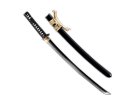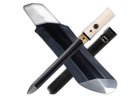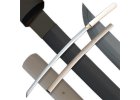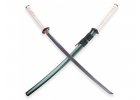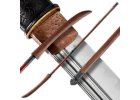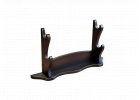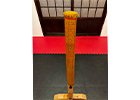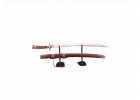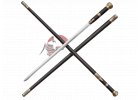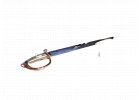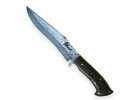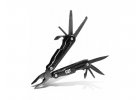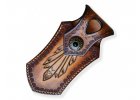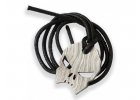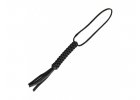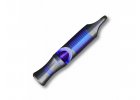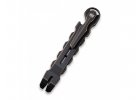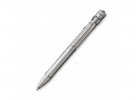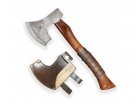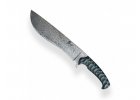Cold weapons are the designation for weapons that do not use a firing mechanism or ammunition and their effectiveness is based on physical contact with the target. This includes various species such as
war hammers clubs and other similar (blunt) toolsBlunt weapons, also called blunt weapons, do not use a blade or a point as their primary strength, but instead rely on their great weight. These weapons focus on amplifying the force of impact when hitting a target. These are various objects that are used to strengthen the force of the blow. The first representatives of this type of weapon were primitive wooden clubs, which are actually the oldest form of weapons. However, with the development of protective devices such as armour, there was a need for weapons capable of overcoming this armour. This saw the rise of grappling weapons, especially during the Middle Ages, when they proved effective against heavily armored knights. Unlike cutting weapons, which required considerable technical skill to penetrate armor, blunt weapons focused on the power of the blow and were less demanding on technical skills. Among the best-known types of crushing weapons are clubs, flails, war hammers, flails, and maces. These weapons have historically proven themselves as effective means of combat and have left their mark on military tactics and strategies.
Cutting weapons
It is a group of weapons that depend for their effectiveness on a sharp blade that facilitates physical damage to the target. The development of cutting weapons reflects the progress of human civilization in the field of craftsmanship, knowledge of materials, especially metals, and in the construction of weapons themselves. The original slashing weapons were made of copper, later of bronze and finally of iron and steel. The original design of these weapons included a simple straight edged blade, making them more effective than previous stabbing or blunt weapons. The main advantages of this type of weapons were their lower weight, high efficiency and easy handling. Over time, the design and basic principles of using these weapons evolved, resulting in the blades being profiled into a curved shape, which increased slashing efficiency but reduced stabbing ability. This led to a clear division of weapons into stabbing and slashing. Among the best-known representatives of this category of weapons are sabers, katanas, and from the category of longer weapons, axes, awls or scythes.
Stabbing weapons
The very name "stab weapon" already suggests its definition. This type of weapon is based on its predecessor, which is a fist wedge mounted on a long branch shaft known as a spear. The original purpose of stabbing weapons was to facilitate hunting, both in water and on land. Over time, this type of weapon improved due to the development of human skills and the use of better materials, making it a key element in the armament of all armies. Among the most famous representatives of this type of weapons are spears, stabbing daggers and rapiers. Throughout history, these weapons have proven to be effective tools both in combat and in hunting and defense.
Throwing weapons
Throwing weapons represent a special category among melee weapons. Their main purpose is to hit a target at a distance using the fighter's strength alone, without using a more complex mechanism like crossbows, bows, or firearms that launch projectiles with the help of a mechanism. Throwing weapons come in a variety of shapes and sizes, from smaller ones like throwing stars to larger ones like harpoons and spears. Among the most famous representatives are spears, shurikens and throwing knives. Historically, these weapons have proven to be effective means of engaging targets at longer distances and were often used in combat situations or hunting.
Historically, cold weapons have been an essential part of military equipment and have been used in many cultures for millennia. However, their importance in combat gradually declined with the advent of firearms. Nevertheless, they remain popular in various martial arts, sports disciplines (such as fencing) and collectibles. Melee weapons can be made from a variety of materials, such as steel, wood, or even modern alloys. Their design varies according to the purpose and historical context in which they were used. Nowadays, they are often used as part of martial arts training, defense techniques or as props in film and theatre. It should be emphasized that cold weapons are still considered dangerous and can cause serious injury or death if used improperly or improperly. For this reason, their ownership and use are regulated by laws and regulations in many jurisdictions.
Cold weapons are actually one of the first creations of human craftsmanship. When we look back at the beginnings of human development and the connection with our ancestors, we find that among the first tools that mankind made were those for hunting game and defense. This range of objects and weapons that can only be called cold weapons includes various types of tools. The first known cold weapon is the famous fist wedge, which laid the foundation for the development of tools and weapons. This fist wedge became the basis for a spear that was used to hunt game, as well as a knife that was useful in everyday life. We can thus consider the invention of the fist wedge as the beginning of the creation of weapons. The main purpose of a cold weapon is to enhance the user's abilities and thereby increase effectiveness in combat. Since ancient times, these weapons have been designed to give an advantage to the user and make it easier for him to achieve his goals in combat situations.

_-_edited.png)
